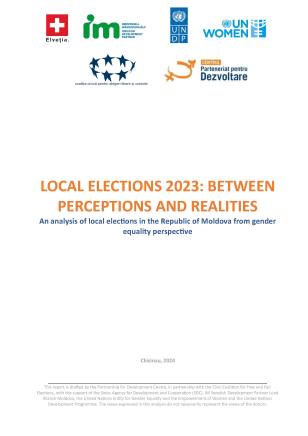Local elections 2023: between perceptions and realities. An analysis of local elections in the Republic of Moldova from gender equality perspective
Local elections 2023: between perceptions and realities. An analysis of local elections in the Republic of Moldova from gender equality perspective
April 16, 2024
This report is drafted by the Partnership for Development Centre, in partnership with the Civic Coalition for Free and Fair Elections, with the support of the Swiss Agency for Development and Cooperation (SDC), IM Swedish Development Partner Lund Branch Moldova, the United Nations Entity for Gender Equality and the Empowerment of Women and the United Nations Development Programme.
The Centre for Partnership for Development (CPD) has been monitoring parliamentary and local elections for about 15 years, analysing women's representation in elections, voter perceptions, political party funding, etc. with the aim of highlighting the main inequalities in terms of women's and men's participation in electoral processes; society's perceptions of women's presence in political life, etc. As part of the observation mission for the 2023 general local elections, CPD aimed to analyse trends in relation to previous elections. Specifically, in the monitoring process, the CPD focused on:
- the representation of men and women on the lists of candidates: compliance with the 40% minimum representation quota for both sexes when drawing up the lists of candidates for the local elections and the positioning of candidates on the lists, in accordance with the latest legislative provision (minimum of four candidates of the opposite sex for every ten seats);
- the income and economic possibilities of women and men candidates: analysis of the income statements of candidates for mayor and correlation with their presence on the lists of candidates;
- access of candidates, especially women, to the media (analysis of four types of media products: news, talk shows, election debates and advertisements, the aim being to identify the level of presence of female candidates in the TV media during the election campaign and to correlate this indicator with their presence on the candidate lists);
- voters' perceptions of female and male candidates (this analysis is based on a survey in which respondents give their opinions on the presence of women and men in politics, gender roles in family, household, and society and how this role influences the involvement of women and men in politics).

 Locations
Locations